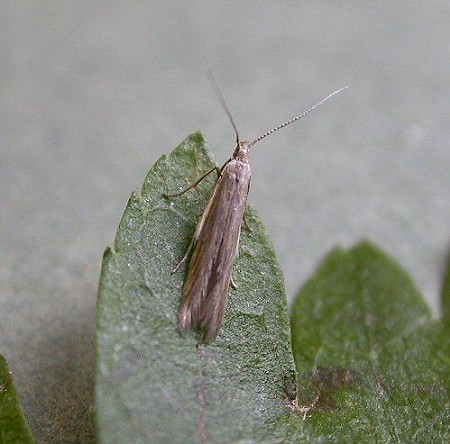37.073 BF584
Coleophora alticolella
Zeller, 1849
Wingspan 10 - 12 mm.
Before 1955, and sometimes more recently, this species was incorrectly called by the name of another Juncus feeding species, C. caespititiella. It is the most widespread and common British Coleophora species, occurring wherever the appropriate rush species grow and seed, up to 660 metres above sea level in some years.
Flight period June and July, possibly late April and May, at sunrise, dusk and night.
The adults resemble several other Coleophora species and are most reliably identified by dissection of the genitalia. The full grown larval case is very similar to that of another Juncus feeding species, C. glaucicolella, but the larvae can be differentiated.
Larva: (description Ian F. Smith)
Foodplants: On the seeds of Juncus squarrosus and J. effusus July - May. Also, J. inflexus, J. conglomeratus ,J. articulatus, J. acutus, J. compressus and J. gerardii.
Diagnostic features to differentiate from C. glaucicolella are in boldface.
Case : Whitish with yellowish brown granules, appearing abruptly in late July or August, about 6 mm long after developing unseen in seedheads. Many overwinter on the ground. Cases which winter on the seed head are often undersized, about 4.5 mm long in April, and contain inactive diapausing, larvae. The posterior end has three crimps, one of which may be positioned centrally on the dorsum.
Larval length: 3mm in April, those on ground may be larger.
Head: Blackish or dark mahogany-brown.
Prothorax (T1): Prothoracic shield coloured as head with pale anterior border and thin medial line. Blackish brown lateral sclerite.
Mesothorax (T2): Two pairs of blackish brown dorsal sclerites, the posterior pair fused into one. Diapausing larvae examined in April had a yellowish white periphery with large central black ellipse in each dorsal sclerite.
Blackish brown lateral sclerite.
Metathorax (T3): No dorsal sclerite. The blackish brown lateral sclerite is only about a quarter the size of the lateral sclerite on T2.
Thoracic legs: Brownish black.
Body: Brown with pinkish orange tint. There is usually a small dull blackish dorsal spot on the posterior margin of segment A9.
Spiracles: Brown.
Setae: Transparent colourless.
Anal plate: Dark chestnut brown.
Prolegs: Coloured as body with dark brown crochets. Anal proleg has large brownish pinaculum postero-laterally.
Comment
To extract a larva from its case, pin the case by its edges to a piece of plastazote or polystyrene meat tray. Slit the case with a needle, operating slowly at alternate ends to give the larva time to withdraw from the needle. In winter and spring the case can be very hard and care is needed to avoid the diapausing larva which can not retreat.

 UKMoths
UKMoths 







